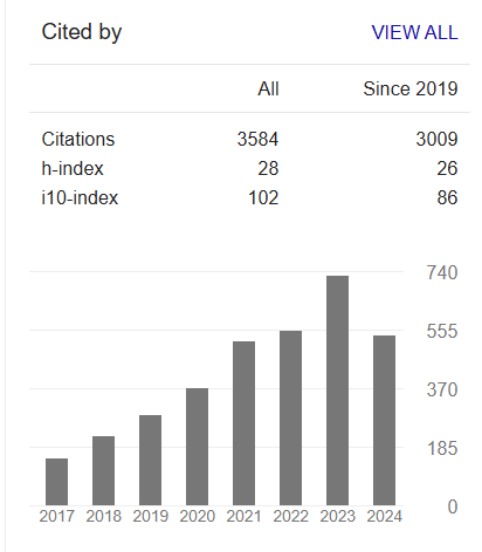Identifikasi Propagul Gulma pada Berbagai Jenis Tanah Sawah
Paiman Paiman(1*), Ardiyanta Ardiyanta(2), C. Tri Kusumastuti(3), Puguh Bintang Pamungkas(4), Muhammad Ansar(5)
(1) Department of Agrotechnology, Faculty of Agriculture, Universitas PGRI Yogyakarta
(2)
(3)
(4)
(5)
(*) Corresponding Author
Abstract
Gulma yang tumbuh ke permukaan tanah berasal dari simpanan biji gulma di dalam tanah. Terdapat banyak propagul gulma yang tersimpan di dalam tanah sawah. Penelitian ini bertujuan untuk mengidentifikasi propagul gulma pada berbagai jenis tanah sawah. Penelitian dilakukan sejak Februari hingga Mei 2019 di rumah kaca Fakultas Pertanian Universitas PGRI Yogyakarta. Percobaan disusun dalam rancangan acak lengkap (RAL) faktorial dan diulang tiga kali. Faktor pertama adalah jenis tanah sawah terdiri atas empat macam, yaitu: tanah pasir pantai, vulkanik, latosol, dan regosol. Faktor kedua adalah kedalaman tanah terdiri atas enam aras, yaitu: 0-5, >5-10, >10-15, > 15-20, >20-25, dan >25-30 cm. Hasil penelitian menunjukkan bahwa jumlah jenis gulma tertinggi pada tanah regosol, kemudian menurun pada tanah pasir pantai dan terendah pada tanah vulkanik dan latosol. Jumlah propagul gulma tertinggi terdapat pada tanah regosol di kedalaman >10-15 cm. Temuan penelitian menunjukkan bahwa ada perbedaan nyata jumlah propagul gulma antar jenis tanah maupun antar kedalaman tanah sawah. Kami menyarankan bahwa untuk pengendalian gulma agar berhasil maksimal, maka perlu disesuaikan dengan jenis tanah sawah untuk budidaya padi.
Keywords
Full Text:
PDFReferences
Aldrich, R. J. 1984. Weed-crop ecology: Principles in weed management. 3rd ed. Breton Publishers, North Scituate, Massachusetts.
Anderson, W. P. 1977. Weed science: Principles. West Publ. Co: St. Paul, N. Y., Boston, San Francisco, New York.
Batlla, D., and R. L. Benech-Arnold. 2007. Predicting changes in dormancy level in weed seed soil banks : Implications for Weed Management. Crop Protection, 26:189–197.
Benech-arnold, R. L., R. A. F. Sanchez, C. Forcella, B. Kruk, and C. M. Ghersa. 2000. Environmental control of dormancy in weed seed banks in soil. Field Crops Research, 67:105–122.
Benvenuti, S., and A. Pardossi. 2017. Weed seed bank dynamics in Mediterranean organic horticulture. Scientia Horticulturae, 221:53–61.
Bruand, A., Hartmann, C., and G. Lesturgez. 2005. Physical properties of tropical sandy soils: A large range of behaviors. Khon Kaen, Thailand.
Christoffoleti, P. J., and R. S. X. Caetano. 1998. Soil seed banks. Sci. Agric., 55:74–78.
Gad, M. R. M., and S. S. Kelan. 2012. Soil seed bank and seed germination of sand dunes vegetation in North Sinai – Egypt. Annals of Agricultural Science, 57:63–72.
Gomez, A. G., and K. A. Gomez. 1984. Statistical procedures for agricultural research. Second edition. New York, Chichester, Brisbane, Toronto, Singapore: John Wiley & Sons, Inc.
Gulshan, A. B., and A. A. Dasti. 2012. Role of soil texture and depths on the emergence of buried weed seeds. Journal of Engineering and Applied Sciences, 7(4):223–228.
Haight, D., S. C. Reed, and A. M. Faist. 2019. Seed bank community and soil texture relationships in a cold desert. Journal of Arid Environments Journal, 164:46–52.
Hossain, M. M., and M. Begum. 2015. Soil Weed seed bank: Importance and management for sustainable crop production - A review. Journal of the Bangladesh Agricultural University, 13(2):221–228.
Hosseini, P., H. Karimi, S. Babaei, and H. Rahimian. 2014. Weed seed bank as affected by crop rotation and disturbance. Crop Protection, 64:1–6.
Jaganathan, G. K. 2018. Physical dormancy alleviation and soil seed bank establishment in Cassia roxburghii is determined by soil microsite characteristics. Flora, 244–245:19–23.
Ling, D., Q. Huang, and Y. Ouyang. 2010. Impacts of simulated acid rain on soil enzyme activities in a latosol. Ecotoxicology and Environmental Safety, 73(8):1914–1918.
Loddo, D., F. Ghaderi-far, Z. Rastegar, and R. Masin. 2018. Base temperatures for germination of selected weed species in Iran. Plant protect. Sci., 54(1):60–66.
Mahgoub, A. M. M. A. 2019. The impact of five environmental factors on species distribution and weed community structure in the coastal farmland and adjacent territories in the Northwest Delta Region, Egypt. Heliyon, 5(4):1–33.
Mavunganidze, Z., G. S., Makunde, A. B. Mashingaidze, O. A. Chivinge, C. Riches, and J. Ellis-Jones. 2014. Effect of period of sugarcane cultivation on the abundance and distribution of weed seeds in the soil profile. Planta Daninha, 32(3):507–13.
Naylor, R. E. L. 2003. “Weed seed biology. Encyclopedia of Applied Plant Sciences. 3:485–492.
Rahman, A., T. K. James, J. Mellsop, and N. Grbavac. 2000. Effect of cultivation methods on weed seed distribution and seedling emergence. New Zealand Plant Protection, 53:28–33.
Rajamuddin, U. A., and I. Sanusi. 2014. Morphological characteristics and soil classification of inceptisol at some land systems in the Jeneponto District of South Sulawesi. Jurnal Agroland, 21(2):81–85.
Riemens, M. M., P. C. Scheepens, and R. Y. Van der Weide. 2004. Dormancy, germination, and emergence of weed seeds, with emphasis on the influence of light. Wageningen.
Sanou, L., P. Savadogo, D. Zida, and A. Thiombiano. 2018. Contrasting land-use systems influence soil seed bank composition and density in a rural landscape mosaic in West Africa. Flora, 1–40.
Siahaan, M. P., E. Purba, and T. Irmansyah. 2014. Composition and weed seed bank density at various soil depth of crop planting area at Balai Benih Induk Tanjung Selamat. Jurnal Online Agroekoteknologi, 2(3):1181–1189.
Valle, S. R., J. Dörner, F. Zúñiga, and D. Dec. 2018. Seasonal dynamics of the physical quality of volcanic ash soils under different land uses in Southern Chile. Soil & Tillage Research, 182:25–34.
Article Metrics
Refbacks
- There are currently no refbacks.
Copyright (c) 2022 Vegetalika

This work is licensed under a Creative Commons Attribution-ShareAlike 4.0 International License.
VEGETALIKA journal indexed by:






